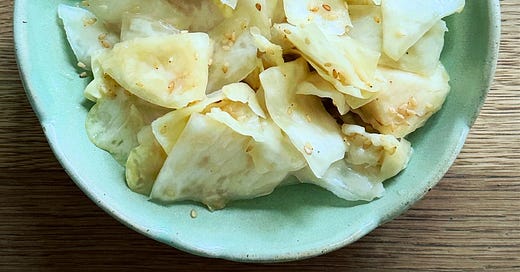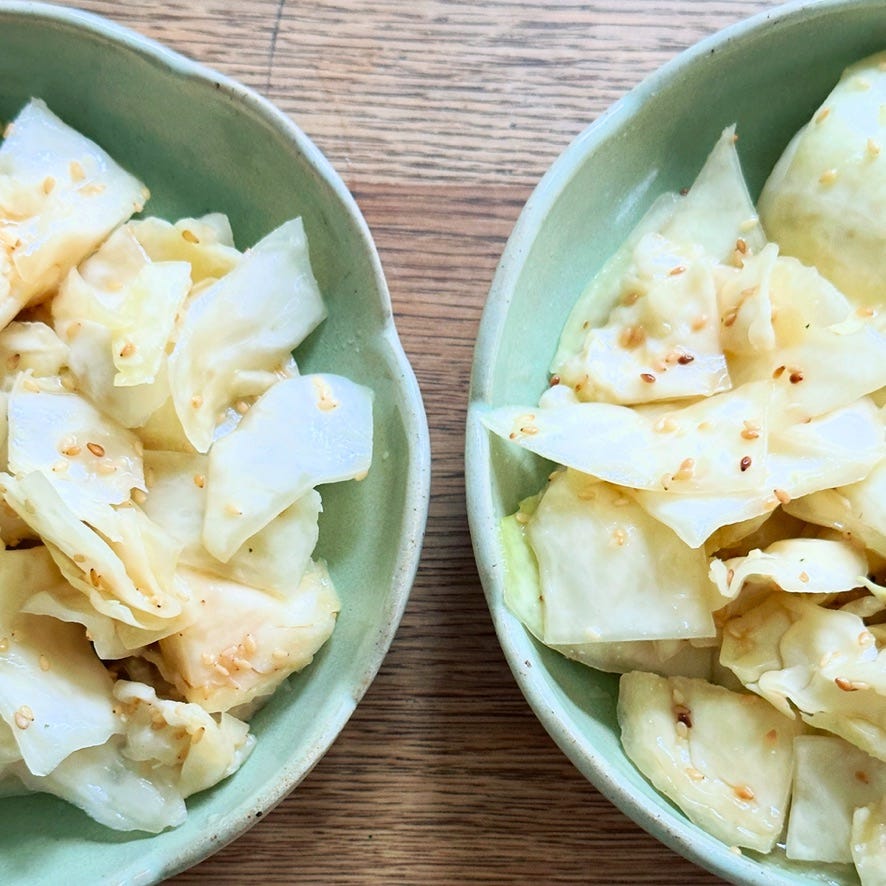In Good Taste #77: Two krauts with sesame seeds
Simple upgrades to white cabbage kraut; do you know what's under Finsbury Park?; talking to strangers
Well, hello there! How are you?
Good I hope.
(Not up for the chitchat? Completely get it. Click the email title to go to a web-based version then jump straight to the recipe or Cultural Fun.
I’m well. Knackered but well. I dashed straight from yesterday’s Lunch Club at the Horsey Vale Community Centre (chicken or bean pie, roast carrots and greens followed by chocolate sponge and custard) to Dalston so I could set up for my class at the Dusty Knuckle. A good day but a long one so, in contrast, I’ll keep this short-ish and skip straight to the recipes.
Recipe: “Addictive” cabbage kraut
My eye was caught the other day by Hetty Liu McKinnon’s newsletter about “addictive” cabbage, a salad often served in izakaya, Japanese pubs. My brother Adam lived in Tokyo for a couple of years and I remember eating something similar when visiting him: an umami-filled but clean-tasting dish, fantastic accompanied by a beer and some yakitori chicken.
I had a cabbage to hand so made it immediately and it was totally delicious. If you have a cabbage nearby I suggest you give it a go.
(I’m not sure whether it’s OK to call a foodstuff addictive these days. I remember when the (New York bakery) Milk Bar changed the name of their famous Crack Pie. Maybe if you addiction is non-specific it’s OK? In any case this salad is definitely moreish.)
HLM’s recipe uses half a cabbage so I wondered what to do with the other half. Would it work as a kraut? I gave it a go and - what do you know - it did! Lacto-fermentation ups the umami and brings some acidity.
Makes one 750ml jar
Ingredients
½ cabbage (approx 750g)
approx 15g salt
3 garlic cloves, minced or grated
2 teaspoons vegetable bouillon powder
2 tablespoons toasted sesame seeds
Method
Slice the cabbage and add salt. Cut the cabbage into quarters and remove the cores. Slice into roughly postage stamp-sized pieces. Weigh the cabbage and calculate 2% of this weight (divide by 100 then multiply by 2). Add this amount of salt and toss it through.
Add the flavourings. Add the garlic, bouillon powder and sesame seeds to the cabbage and toss again until well combined.
Leave to produce brine. Let the cabbage sit for half an hour or so. There should be a small puddle of brine at the bottom of the bowl.
Pack into a jar and weigh down. Put the cabbage in the jar a handful at a time, packing it down firmly to remove any air pockets. Add any brine from the bowl. There should be enough liquid so that when you push down firmly on the cabbage, brine rises up around it and covers it. Use a glass or ceramic pickle weight, a plastic bag filled with water or your cabbage cores to keep everything submerged.
Leave to develop. Seal the jar and put it somewhere at room temperature but out of direct sunlight. Every few days open it up to let out any gas that has collected and to taste a little kraut. When the umami flavour is balanced by an acidity you enjoy, move it to the fridge. This will probably take about a week.
Notes (If Ifs And Ands Were Pots And Pans…)
I usually give a white cabbage kraut a couple of weeks at least, but I think this one is best eaten young. Half way between a salad and a kraut whilst you still have a hint of the fresh cabbage taste alongside the umami and acidity. Mine was delicious after a week.
The bouillon powder contains salt which is why I’m using 2% here by weight rather than my usual 2.5.
The recipe for the original salad included sesame oil. I’d encourage you to serve this with a drizzle as it’s delicious and really adds to the flavour but don’t add it to the ferment as using oils has a (very small but real) risk of botulism. The sesame seeds themselves contain oil but this is safe as it’s safe within their cell walls.
Even if you buy sesame seeds that describe themselves as “toasted” I would give them a couple of minutes in a dry frying pan until properly browned and nutty smelling. You get a much better flavour that way. Let them cool completely before adding to the cabbage.
I kept the roughly chopped presentation of HLM’s salad and enjoyed the textural contrast. But you could obviously do this as a regular shredded kraut too. I think that would be a delicious addition to a sandwich of soft white bread, crispy fried chicken and Kewpie mayo…
Recipe: Preserved lemon and sesame kraut
This is another simple but lovely kraut elevated by sesame.
Makes one 750ml jar.
Ingredients
½ cabbage (approx 750g)
approx 20g salt
1 tablespoon preserved lemon purée
2 tablespoons toasted sesame seeds
Method
Shred the cabbage and add salt. Cut the cabbage into quarters, remove the cores and shred the leaves finely. Weigh the cabbage and calculate 2.5% of this weight. Add this amount of salt and toss it through.
Add the flavourings. Add the preserved lemon and sesame seeds to the cabbage and toss again until well combined.
Leave to produce brine. Let the cabbage sit for half an hour or so. There should be a small puddle of brine at the bottom of the bowl.
Pack into a jar and weigh down. Put the cabbage in the jar a handful at a time, packing it down firmly to remove any air pockets. Add any brine from the bowl. There should be enough liquid so that when you push down firmly on the cabbage, brine rises up around it and covers it. Use a glass or ceramic pickle weight, a plastic bag filled with water or your cabbage cores to keep everything submerged.
Leave to develop. Seal the jar and put it somewhere at room temperature but out of direct sunlight. Every few days open it up to let out any gas that has collected and to taste a little kraut. When the umami flavour is balanced by an acidity you enjoy, move it to the fridge. This will probably take about 10 days.
Notes (If Ifs And Ands Were Pots And Pans…)
The fact that the lemons are already fermented seems to get this going pretty quickly. Where a plain kraut would take two weeks, this is usually ready in about 10 days.
Toss into salads or eat alongside stews to bring a little acidity and cut through the richness.
Cultural Fun
Any readers local to me in North London may recognise this unremarkable-looking bit of Finsbury Park. What’s that small building? A gardener’s shed for keeping tools perhaps?
In fact it’s the entrance to an underground reservoir, built in the 1860s. I first heard about it more than a decade ago on the “urban exploration” website Stray Off The Path then in 2016 a photographer called Matt Emmett won the Architectural Photographer of the Year with a picture of the cistern. It now crops up regularly on Instagram and elsewhere online.
I think about it every time I walk down the main avenue of Finsbury Park. Maybe you will now too.
I am so delighted by the return of Answer Me This! 18 years after the first episode was released (and nearly four since they retired) Helen and Olly brought AMT back in a new monthly format.
I mentioned Miranda July’s book All Fours when I first read it last year. Hailed as the “first perimenopause novel” it deals with desire and creativity and hormores and marriage and all sorts of other stuff. It totally blew me away and I’m clearly not the only one. Miranda July recently joined Substack and a whole community has blossomed in the comments section, including IRL meet-ups to discuss the book. I met a group of complete strangers on Monday in a bar near Kings Cross and had a crazily honest, vulnerable and revealing conversation with women I’d likely never otherwise have encountered. Talking to strangers: recommended.
Bye! See you next week!
In the meantime, if you felt like sharing In Good Taste with friends or family who might enjoy it, you can do so with the button below.
Or upgrade to paid to support the work I do. Either would mean a lot to me. Thanks so much.
In Good Taste is a Sycamore Smyth newsletter by me, Clare Heal.
It’s free to subscribe and new issues will appear in your inbox every Thursday.
You can also access it via the Substack website or app where each issue remains free or a month after publication but older posts and archive access are for paid subscribers only. If you can afford it, do consider upgrading to paid to support my work - those vegetables won’t ferment themselves...
I also occasionally include affiliate links to Bookshop.org and will earn a small commission on anything purchased via a clickthrough.
You can also find me on Instagram or visit my website to find information about my catering work, cookery lessons and upcoming events.









Oooh, I saw that HLM cabbage recipe and love the idea of turning it into a kraut. Will have to give this a go. If you've got her book Tenderheart, there's another cabbage recipe in there that I find completely addictive: tangy stir-fried cabbage with glass noodles. I love it at room temperature or even cold straight from the fridge.